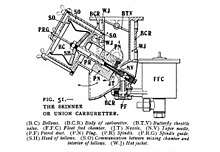George Herbert Skinner
George Herbert Skinner (1872–1931) was a British boot and shoe manufacturer, enthusiastic pioneer motorist[1] and inventor of a well-known carburettor which remained in production almost the entire twentieth century until superseded by fuel injection systems.
Biography
Herbert Skinner was born in 1872 in Wellingborough the eldest son of boot and shoe manufacturer William Banks Skinner (1847-1914) and his wife born Jane Lilley.[2] In 1881 Banks Skinner entered into a partnership with his brother-in-law, Thomas Lilley (1845-1916), and they built a very successful footwear manufacturing and retailing business, Lilley & Skinner.
The eldest son, Herbert Skinner followed his father into the management of Lilley & Skinner.[3] He brought back Britain's first modern shoe-making machinery from an 1895 visit to USA.[1]
He acquired his first car in 1898 and actively participated in the development of the petrol engine.[1] Herbert with his brother Carl, Thomas Carlisle Skinner (1882-1958), made a newly developed carburettor in 1904.[4] In February 1905 Herbert applied for a full patent[5] which was granted in January 1906.[6] The new carburettor was made for the Skinner brothers by G Wailes & Co of Euston Road until the brothers formed a limited liability company in August 1910[note 1] to manufacture it themselves.[1] The original brand name Union Carburettor was changed to S. U. carburettor, an abbreviation of Skinner-Union.[7][8][9][10] Younger brother, Carl (Thomas Carlisle) Skinner (1882-1958) sold out of Lilley & Skinner and took over the carburettor business. Herbert remained with Lilley and Skinner[11] and continued to patent improvements to his carburettor.[4][12]
He was one of the founders and the vice-president of the Institute of Patentees and well-known in the City of London as an active member of the Cordwainers' Company. He represented England as a clay-bird shot in the 1908 Olympic Games and won a bronze medal.[1]
Herbert was father of Professor Herbert Skinner. He did not believe in early schooling. His son was nine years old before he entered Durston House School at Ealing.[5]
Herbert Skinner died suddenly at his house in Woodville Road, Ealing on 29 December 1931 aged 59.[13]

Notes
- S. U. Company Limited, 386—388 Euston Road, N.W. Capital £5,000 in £1 shares. Formed to acquire from G. H. Skinner certain inventions relating to carburettors for motorcars &c
New Companies Registered. Private Companies. The Automotor Journal, 24 September 1910
References
- Obituary. Mr. G. H. Skinner. The Times, Wednesday, Jan 06, 1932; pg. 12; Issue 46023
- FindMyPast census records
- 'Lilley & Skinner, The Times, Tuesday, Jun 02, 1896; pg. 14; Issue 34906
- E A Forward, Handbook of the Collections illustrating Land Transport, II. Mechanical Road Vehicles, Science Museum South Kensington, 1936
- H. Jones: Herbert Wakefield Banks Skinner. 1900-1960. Biographical Memoirs of Fellows of the Royal Society, Vol.6, (Nov. 1960), pp.259-268, publisher: The Royal Society
- 3257 G H Skinner, Carburetting apparatus. reported in page 152, AutoMotor Journal 3 February 1906
- Profile Professor Herbert Skinner, The New Scientist 14 November 1957
- James Leasor, Wheels to Fortune, Stratus, Cornwall 2001 ISBN 0755100476
- Colin Campbell, Tuning for Economy, Springer 1981 ISBN 9780412234903
- Nick Meikle, Malloch's Spitfire: The Story and Restoration of PK350, Casemate 2014 ISBN 9781612002521
- Obituary. Mr. Thomas C. Skinner The Times, Saturday, Nov 15, 1958; pg. 10; Issue 54309
- Skinner-Union Carburettor Improvement. page 28, The Commercial Motor, 24 August 1920
- Deaths. The Times, Thursday, Dec 31, 1931; pg. 1; Issue 46018